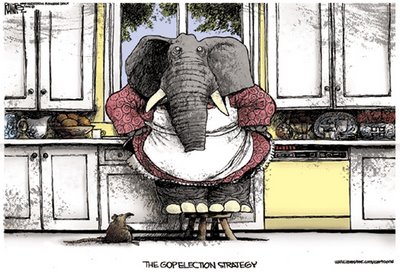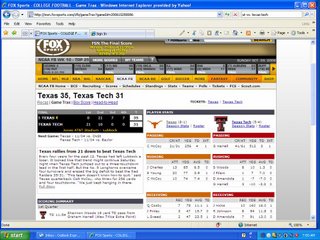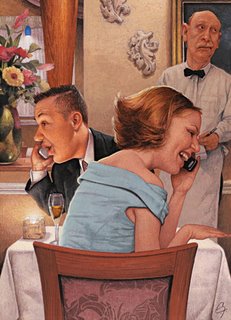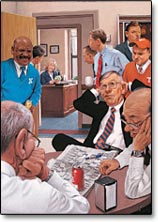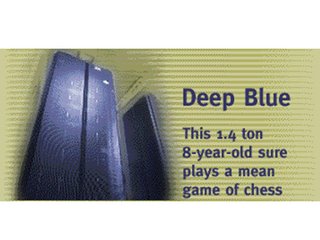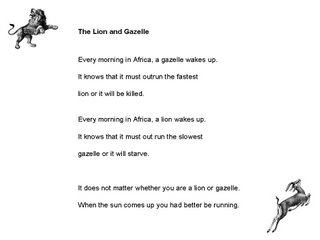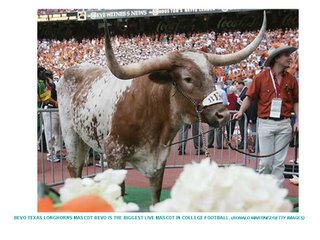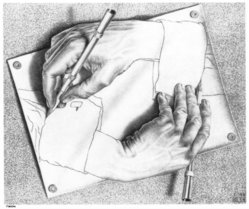Tuesday, October 31, 2006
GOP Election Strategy
Monday, October 30, 2006
Serenity Prayer
God grant me the serenityRandom Quote:
to accept the things I cannot change;
courage to change the things I can;
and wisdom to know the difference.
Living one day at a time;
Enjoying one moment at a time;
Accepting hardships as the pathway to peace;
Taking, as He did, this sinful world
as it is, not as I would have it;
Trusting that He will make all things right
if I surrender to His Will;
That I may be reasonably happy in this life
and supremely happy with Him
Forever in the next.
Amen.
--Reinhold Niebuhr
A hen is only an egg's way of making another egg. - Samuel Butler
Sunday, October 29, 2006
Day Light Saving Time
Terre Haute is about 30 minutes drive from Robinson (~45 miles) and follows EST w/o DST at that time*. So, after "Spring forward", time in Robinson and Terre Haute used to be the same. However, on "Fall Back" (i.e., during normal time), Terre Haute used to be an hour ahead. So, we used to leave Terra Haute at ~ 10 PM after dinner during normal time, and reach Robinson at 9:30 PM!
Here are a few more weird things related to day light saving time.
- To keep to their published timetables, trains cannot leave a station before the scheduled time. So, when the clocks fall back one hour in October, all Amtrak trains in the U.S. that are running on time stop at 2:00 a.m. and wait one hour before resuming. Overnight passengers are often surprised to find their train at a dead stop and their travel time an hour longer than expected. At the spring Daylight Saving Time change, trains instantaneously become an hour behind schedule at 2:00 a.m., but they just keep going and do their best to make up the time.
- A man, born just after 12:00 a.m. DST, circumvented the Vietnam War draft by using a daylight saving time loophole. When drafted, he argued that standard time, not DST, was the official time for recording births in his state of Delaware in the year of his birth. Thus, under official standard time he was actually born on the previous day—and that day had a much higher draft lottery number, allowing him to avoid the draft.
- In September 1999, the West Bank was on Daylight Saving Time while Israel had just switched back to standard time. West Bank terrorists prepared time bombs and smuggled them to their Israeli counterparts, who misunderstood the time on the bombs. As the bombs were being planted, they exploded—one hour too early—killing three terrorists instead of the intended victims—two busloads of people.Click here for more weird stuff. And some good things...
Following the 1973 oil embargo, the U.S. Congress extended Daylight Saving Time to 8 months, rather than the normal six months. During that time, the U.S. Department of Transportation found that observing Daylight Saving Time in March and April saved the equivalent in energy of 10,000 barrels of oil each day - a total of 600,000 barrels in each of those two years.* Now all Indiana follows DST. Still, some counties are in CST while others are in EST.
Likewise, in 1986, Daylight Saving Time moved from the last Sunday in April to the first Sunday in April. No change was made to the ending date of the last Sunday in October. Adding the entire month of April to Daylight Saving Time is estimated to save the U.S. about 300,000 barrels of oil each year.
Beginning in 2007, Daylight Saving Time will commence on the second Sunday in March and end on the first Sunday in November, thereby saving even more energy
Correction to the Original Posted: Changed "Terra Haute" to "Terre Haute" as a correction.
Saturday, October 28, 2006
The Wood Guy
Technology for Country Folks
Friday, October 27, 2006
Trading Up Paper Clip for a House!
 I extracted this incredible (and fairly well known) story of how one man swapped a paper clip for a house from November 2006 edition of Reader's Digest.
I extracted this incredible (and fairly well known) story of how one man swapped a paper clip for a house from November 2006 edition of Reader's Digest. Take two vegetarians from Vancouver, a ceramic artist from Seattle, a shock-rock legend, a TV star turned Hollywood producer, a town with an impish sense of humor, a whimsical quest dreamed up by a 25-year-old free spirit, mix them together and what do you get? One of the most improbable swaps imaginable: a paper clip for a house.
It all began the summer of 2005. Kyle MacDonald was a restless young Canadian who asked himself a simple question: How far could he get if he played Bigger and Better, a kids' scavenger hunt game, on the Internet? The way it worked was players took a mundane item -- say, a pencil -- then scattered out into the neighborhood, knocked on doors, traded up, then reconvened and voted on who had made the biggest and/or best swap. "I decided instead of knocking on a neighbor's door, it would be fun to knock on the Internet's door and see what people had to offer," Kyle explains simply. It was pointless, yes. It was goofy, certainly. But it was fun.
So Kyle sat down in his parents' house in Vancouver, British Columbia, took a photo of a little red paper clip that was sitting on the desk and put this notice in the barter section of the local craigslist, the classified-ads website: "I want to trade this paper clip with you for something bigger or better, maybe a pen, a spoon, or perhaps a boot. If you promise to make the trade, I will come and visit you."
Not far away, Rhawnie Vallins heard her roommate and fellow vegetarian, Corinna Haight, read Kyle's posting. "We were, like, is this guy serious?" Rhawnie phoned Kyle and found out that indeed he was. The silliness of it was so appealing they agreed to swap a wooden novelty pen shaped like a fish for the paper clip.
The next morning, a laid-back guy with curly hair met Corinna and Rhawnie in the parking lot of a 7-Eleven. They made the swap, took some photos and promised to keep in touch. The game, as Sherlock Holmes would say, was afoot.
Because Kyle had a) promised to make every trade face-to-face but b) had no money, he was limited to places he could visit cheaply or for free or that were easy to get to from his apartment in Montreal.
His next trade was in Seattle because he and his family were on their way to a Mariners game. They stopped to see Annie Robbins, a ceramics artist. Kyle checked out her array of items -- a banana, a container of fish food and a little ceramic knob made by an eight-year-old boy. The knob had an odd face -- a bug-eyed stare and a squiggly smile. "It looked like E.T. after he had taken a lot of drugs," Kyle says. He went straight for it.
Next up was a two-burner camping stove offered in Amherst, Massachusetts. Kyle took it partly because the trader, a craigslist devotee, begged for the little knob ("I HAVE to have it. It would be perfect for the top of my espresso maker"), and partly because Amherst was on Kyle's way to Manhattan, where he was meeting friends. The stove then went west with Kyle and his mom to Camp Pendleton in California where they exchanged it with a U.S Marine for a small gas-powered generator.
By then it was late summer and the offers were petering out. Kyle had a generator he didn't need, a game no one wanted to play anymore and an amusing little experiment that was dead in the water.
He was ready to drop it in November, but decided to give it one last shot. He spent a night, as he put it, "hammering together" a blog, which he called oneredpaperclip.com. In it he announced he was trading from a paper clip up to something bigger and better: a house.
Within 24 hours of putting the word out, Kyle got 120,000 hits, a vast improvement over the 20 or so he'd been getting before. In webspeak, his site had gone viral. The trade offers poured in.
The list reads like a dadaist garage sale: 10,000 lifetime memberships to a date-a-golfer service, 1,000 Glow Stick Powered Basketballs, a 1974 fire truck, a tour of Air Force Two, a partly burned-down house in Newfoundland, ten pieces of tile from one of Saddam Hussein's castles, ten hectares of land in Bosnia and Herzegovina, a set of 14-karat removable gold teeth, a three-foot shark, a dozen quarts of homemade sauerkraut, one slightly used engagement ring, a herd of eight cows in Australia, and -- his two favorite strange items -- a total-body hair removal (available only in Tennessee and Kentucky), and a full-body tattoo.
By June, Kyle's trades had gone from the red paper clip, the fish pen, the funny-faced knob, the camping stove and the gas-powered generator to ...
A neon beer sign and a beer keg Kyle dubbed the One Instant Party kit. He traded it to ...
A DJ in Canada for a snowmobile that was traded to ...
A staffer at a snowmobile magazine that flipped it for a snowmobile trip in British Columbia to ...
An outdoor enthusiast who offered a five-ton truck that was handed off to ...
A record producer for a recording contract that was passed on to ...
A "bohemian geek soul" singer in Phoenix for a year's rent in her duplex to ...
A waitress in Phoenix who offered an afternoon with her boss.
Huh?
Now, her boss was Alice Cooper. That's right, the snake-handling, ghoulish, shock-rock pioneer who is a Phoenix resident and the owner of Alice Cooper'stown, the restaurant where the waitress worked. "I can't believe Kyle's getting me to trade myself for him to get a house," said Alice, "but it's just crazy enough that I couldn't resist."
Word spread, triggering a tsunami of offers from Cooper fans. Of them, Kyle selected a rock-and-roll snow globe with the KISS rock-band logo and a guitar inside. Oneredpaperclip.com fans went ballistic at such a bonehead trade.
But there was a method to Kyle's madness, and we're getting ahead of the story. Two months before, producer Corbin Bernsen, best known for his acting role in the hit TV series, L.A. Law, heard Kyle being interviewed on the radio. Bernsen was writing a psychological thriller called Donna on Demand, and decided to offer a part in the movie.
Kyle loved the idea but had nothing to trade.
Weeks later, he was talking to one of the Alice Cooper bidders, Mark Herrmann, an aspiring rock-concert photographer. "I really wanted to trade with him, but nothing he was able to offer seemed like a step closer toward the house," Kyle says. "Then, in a sort of eureka moment, I thought of Corbin." Kyle knew that Bernsen has a world-class collection of more than 6,000 snow globes. "I said, 'Mark, you might think I'm crazy, but do you have any snow globes?' His answer was, 'Yes. I have a KISS snow globe.' "
The next call was made to Bernsen, who said, "Not only do I want that snow globe, I need it!"
By then it was late June. The pressure was on. Months before, Kyle had let slip to a reporter that he hoped to get a house by July 12, the anniversary of the day he came up with the idea. So here he was, three weeks before the deadline and no sign of a house. Kyle was nervous.
Out of the blue, he got a call from Kipling, Saskatchewan, a small town (pop. 1,100) that's just over the U.S.-Canadian border near Minot, North Dakota. Kipling made Kyle an offer.On July 12, 2006, precisely one year after he began his journey, Kyle accepted the keys to a three-bedroom house at 503 Main Street in Kipling. Out front stood a 12-foot-tall red paper clip that the town had built.
Nearly two months later, on Labor Day weekend, the little town of Kipling held what Kyle termed Saskatchewan's Biggest Housewarming Party Ever, about 2,000 strong. Corbin Bernsen was there, holding an open audition for his movie, as were 12 of the 14 traders.
On the last day, Kyle borrowed the original red paper clip from Corinna Haight, bent it into a ring, then got down on one knee and proposed to his French Canadian girlfriend, Dom, who replied, "I guess I have to say oui."
By the time it was over, Kyle's site had over 7 million hits, and he had a contract for a book and a deal for a movie.
Looking back, Kyle says the best part of the whole project was the pure fun of it. "Everyone asks what was your favorite trade. The one red paper clip for the fish pen. That's it," he says softly. "There's no argument."
Thursday, October 26, 2006
Payne Paintings
Title: Table for Two (unfortunately, not a very rare sight)
Title: March Madness (how true?!)
Title: Waste Lines (A classic, recycle basket, H2 Hummer, and she chose paper to plastic bags!)
A great bumper sticker:
Does the name Pavlov ring a bell?
Wednesday, October 25, 2006
Kopi Luwak Coffee (aka cat poop coffee!)
 If you still have that yucky feeling about Fig Newtons you consumed with pleasure, here is some information that accelerates the "getting over it" process! You probably noticed this in the Encarta link that I provided in my previous Blog on Fig Newtons.
If you still have that yucky feeling about Fig Newtons you consumed with pleasure, here is some information that accelerates the "getting over it" process! You probably noticed this in the Encarta link that I provided in my previous Blog on Fig Newtons. Think of all the folks who live in Beverly Hills and enjoy Kopi Luwak coffee, the world's most expensive coffee at U.S. $75 per quarter pound (about 30,000 Indian Rupees per kilo gram!). This coffee is harvested from the partially digested coffee beans found in the feces of the palm civet (seen in Picture to the left), a distant cousin of the mongoose.
I remember reading about this in USA today a couple of years ago. I couldn't believe it! Who in the world would think on coming across a pile of mongoose droppings "gee, I wonder how it tastes if I grind it and make coffee out of it?!" I have a feeling that the French have a hand in this discovery! - they are the ones who were curious enough to find that Escargots are edible! I also believe that genuine American marketing ingenuity is at least in part responsible for making this the most expensive coffee in the world! It is hard to imagine that it costs an arm and a leg to consume mongoose c%^p (a word that rhymes with trap)!
Related quote:
The only reason a great many American families don't own an elephant is that they have never been offered an elephant for a dollar down and easy weekly payments. ~Mad Magazine (as provided by Raama)
Yummy! Crunchy Fig Newtons!
While going back to India in October 2006, my good friend Rambabu mentioned that he bought a pack of Fig Newtons as he liked them. I too eat them once in a while. Now, Encarta says that the little bit of crunch in Fig Newtons could be due to the bugs that inadvertently get into the fig paste!
TheOn going through the FDA website, I noticed that I too probably have been eating all kinds of stuff that rhymes with "trap" unknowingly! Oh well, we are nothing but the nature's recyclers, like rest of the carbon-based life forms. Bon Appetit!The Food and Drug Administration (FDA) allows for fig paste to have up to 13 insect heads per 100 grams (see table in the FDA link). Because the fig bears its flowers inside the fruit and relies upon wasps to crawl inside to pollinate them, many wasps end up harvested along with the figs. Even with rigorous cleaning and sorting of the figs, it would be nearly impossible to remove every single wasp from inside the figs. So, the crunch is mostly from the fig's seeds, but there may be a wasp head or two in the paste as well.
Related quote:
Eat s%&#, 1,000 billion flies can't be wrong! - Source Unknown
Tuesday, October 24, 2006
Kasparov's Blues!
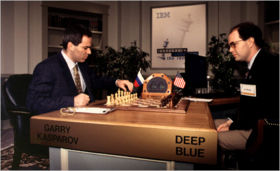 Rented and watched a BBC Documentary Game Over: Kasparov and the Machine yesterday. It is about a rematch of chess games between Garry Kasparov and Deep Blue Computer of IBM in 1997 in New York. It wasn't exactly one of the most exciting documentaries that I ever watched! However, I did learn a few interesting things. During and after the matches, Kasparov complained that the rules and the way the games were played were not fair. Not knowing the whole story, I used to think that his allegations were totally baseless. Now, even though I believe that all his allegations are not valid, I think that he had a point to an extent. I posted all six games of 1997 rematch at the end of this Blog Post. Here is the scoop:
Rented and watched a BBC Documentary Game Over: Kasparov and the Machine yesterday. It is about a rematch of chess games between Garry Kasparov and Deep Blue Computer of IBM in 1997 in New York. It wasn't exactly one of the most exciting documentaries that I ever watched! However, I did learn a few interesting things. During and after the matches, Kasparov complained that the rules and the way the games were played were not fair. Not knowing the whole story, I used to think that his allegations were totally baseless. Now, even though I believe that all his allegations are not valid, I think that he had a point to an extent. I posted all six games of 1997 rematch at the end of this Blog Post. Here is the scoop:The computer system dubbed "Deep Blue" was the first machine to win a chess game against a reigning world champion (Garry Kasparov) under regular time controls. This first win occurred on February 10, 1996, and Deep Blue - Kasparov, 1996, Game 1 is a famous chess game. However, Kasparov won 3 games and drew 2 of the following games, beating Deep Blue by a score of 4 - 2. The match concluded on February 17, 1996.Deep Blue was then heavily upgraded (unofficially nicknamed "Deeper Blue") and played Kasparov again in May 1997, winning the six-game rematch 3.5 - 2.5, ending on May 11th, finally ending in game six. Deep Blue thus became the first computer system to defeat a reigning world champion in a match under standard chess tournament time controls.
After losing the match, Kasparov said that he sometimes saw deep intelligence and creativity in the machine's moves, which he could not understand. He also suggested that humans may have helped the machine during the match. His argument was based on the fact that other computer programs at that time could not find some of the strong moves that Deep Blue did. In particular, 37. Be4 in the second game. However, recent computer programs such as Rybka and the Computer Assistant Project find this move. In addition, Kasparov said the program played a human-like mistake on move 44. Kf1 in the same game. However, recent programs also make the same mistake. Kasparov demanded a rematch, but IBM declined and retired Deep Blue.
Deep Blue's evaluation function was initially written in a generalized form, with many to-be-determined parameters (e.g. how important is a safe king position compared to a space advantage in the center, etc.). The optimal values for these parameters were then determined by the system itself, by analyzing thousands of master games. The evaluation function had been split into 8,000 parts, many of them designed for special positions. In the opening book there were over 4,000 positions and 700,000 grandmaster games. The endgame database contained many six piece endgames and five or fewer piece positions. Before the second match, the chess knowledge of the program was fine tuned by grandmaster Joel Benjamin. The opening library was provided by grandmasters Miguel Illescas, John Fedorovich and Nick De Firmian. Deep Blue's programmers tailored the computer program to beat Kasparov by studying in great detail prior games Kasparov had played. When Kasparov requested that he be allowed to study other games that Deep Blue had played so as to better understand his opponent, IBM refused.I think that the rematch was not fair because Kasparov was not given access to the input given to Deep Blue (for whatever it was worth), while a group of Grand Masters carefully programmed Deep Blue specifically to play against Kasparov. So, Deep Blue had a very good understanding of Kasparov, while Kasparov had no clue on the strengths and weaknesses of Deep Blue. I think allegations by the highest ELO rated player ever, deserve some attention.
The game Arimaa was invented by Omar Syed, a computer engineer trained in artificial intelligence. Syed was inspired by Garry Kasparov's defeat at the hands of the chess computer Deep Blue to design a new game which would be difficult for computers to play well, but would have rules simple enough for his four-year-old son Aamir to understand. ("Arimaa" is "Aamir" spelled backwards plus an initial "a"). In 2002 Syed published the rules to Arimaa and announced a $10,000 prize, available yearly through 2020, for the first computer program (running on inexpensive, off-the-shelf hardware) able to defeat a top-ranked human player in a match six games or longer. Syed has applied for a patent on the Arimaa rules, and the name "Arimaa" is trademarked.
Monday, October 23, 2006
Sunday, October 22, 2006
Saturday, October 21, 2006
Dr. Weinberg's Take on Intelligent Design
With or without religion, good people can behave well and bad people can do evil; but for good people to do evil - that takes religion.I also liked the following Richard Feynman's quote he referenced:
When you look at the universe and understand its laws, 'the theory that it is all arranged as a stage for God to watch man's struggle for good and evil seems inadequate.While reading Dr. Weinberg's article, I was hoping that he would bring up a few fundamental questions for which we have no answers. They are, where did the pre-big bang dense matter come from? If it was a speck from other bang bangs (like he said), where did the matter for those big bangs come from? NASA says that our universe might be oval-shaped. What would be on the other side of the oval? This kind of reasoning makes me believe in the existence of a higher power.
My intuition tells me that our universe was created by intelligent design. I believe that intelligent design need not be a contraction to Darwin's theory of evolution. Though our Designer may not have created "the life" per se (as The Holy Bible says), I think It started the process by generating the matter, and probably even creating conducive conditions for origin of our APPARENT intelligence. A side note - I am very happy to learn that The Complete Works of Charles Darwin Online was posted on the internet yesterday. It is always good to have the Master's works handy, even for a novice.
I find it very hard to believe that the matter has been there from time immemorial. The way a "desire" to continue existence originated in an inanimate object (single cell) at a snap shot of time (i.e., life from non-life), matter could have originated from Sunya through intelligent design. In fact, I believe that the matter we perceive as real, is very likely a fragment of our imagination as indicated by Peter Russell in his excellent articles related to matter and consciousness.
One might ask then, why was this Blog titled "Cogito, Ergo Sum"?! A very good question. My answer is, though I believe that the reality most probably is an illusion, unfortunately, like almost all of us (janata), I am not absolutely convinced. I think that only a few enlightened ones (Gyanis/Yogis) base their actions on thoroughly-internalized conviction that what we perceive as reality, is an illusion. The rest of us are busy with what I call, our peacock dances in trying to impress the irrelevant, and illusionary sensual gratifications. I titled my Blog "Cogito, Ergo Sum" as it accurately describes my belief, be it right or wrong. I am looking forward to changing my conviction (and hence the title of this Blog) ASAP! As Thomas Carlyle said:
The Greatest of faults, I should say, is to be conscious of none.Finally, I am also puzzled as to why so many theorists imply that the absence of hydrogen, carbon, and oxygen implies the absence of intelligence (e.g., if there is no water on Mars, it is not possible for intelligence to exist on that planet). Isn't it like saying that if there is no wood, there wouldn't be any baseball bats? Sure, baseball bats were made exclusively out of wood for a long time. But slowly we started making these bats out of metal and we get pretty darn good baseball bats made of material other than wood now.
Similarly, just because we see intelligence associated with only carbon-based life forms around us, we can't say that other elements are not capable of producing such intelligence. For that matter, I don't feel that material is necessary for producing intelligence. Since we know that our perceived intelligence is carbon based, looking for hydrocarbons (plus oxygen) is just a good starting point - that's all.
Somewhat related quote:
Look at all the stars. You look up and you think, "God made all this and He remembered to make a little speck like me." It's kind of flattering, really.- Morgan Earp in the movie "Tombstone"
Friday, October 20, 2006
Strange Loops
Text Source: My ex-colleague and good friend, Steve. Picture Source: Wikipedia
The concept of Strange Loop is an invention of Douglas Hofstadter, who made them a theme of his master work, Gödel, Escher, Bach [Hofstadter 1989]. He says that a strange loop occurs "whenever, by moving upwards (or downwards) through the levels of some hierarchical system, we unexpectedly find ourselves right back where we started."
In the forest (the biological one), if we start at the level of soil, water and the debris on the forest floor, we can follow the path of this material as it's integrated with seeds, sunlight, air and more water into a tree. And it stays in the tree for a very long time. Some of it falls back to the floor either as last year's leaves or as deadfall, until the tree dies and it, too, falls to the floor. And so we have returned to where we began.
This cycle supports a feedback loop. For example, if, over several years, the trees reproduce too rapidly, too much of the material of the forest will become tied up in young trees, which makes it difficult for trees to reproduce, thus regulating the population. But that feedback loop isn't a strange loop. What makes the cycle a strange loop is that the trees can influence the way the forest builds itself by communicating with their environment at a higher level. For instance, they can adjust the composition of the forest floor in ways that influence the composition of the tree population. This is how the resin and needle mass in the floor of a pine forest defends the territory of the pines, by preventing colonization by other varieties. In effect, the action of the pines adjusts their own environment to favor pines over other trees. This is what makes the material cycle of a forest system a Strange Loop.
In the Forest of Ideas, we begin with the pieces of thoughts, ideas and feelings from which workable ideas are made. And we use those ideas for a long time, until they're outmoded, turned into history, by changes in the environment. But from those old ideas can come new thoughts, that will eventually find their way into new ideas, which in turn change our connections to the old ideas.
To understand the power of strange loops, consider a parable that has been floating around the Internet of late. It's often presented as an explanation for the origins of organizational policy, and sometimes goes by the name "Primate Thinking Committee Experiment." Although the parable is widespread, nobody seems to know its origin.
Start with a cage containing five monkeys. In the cage, hang a banana on a string and put a set of stairs under it. Before long, a monkey will go to the stairs and start to climb toward the banana. As soon as he touches the stairs, spray all of the monkeys with cold water.
After a while, another monkey makes an attempt with the same result — all the monkeys are sprayed with cold water. Pretty soon, when a monkey tries to climb the stairs, the other monkeys try to prevent it.
Now, turn off the cold water. Remove one monkey from the cage and replace it with a new one. The new monkey sees the banana and wants to climb the stairs. To his horror, all of the other monkeys attack him. After another attempt and attack, he knows that if he tries to climb the stairs, he'll be assaulted.
Next, remove another of the original five monkeys and replace it with a new one. The newcomer goes to the stairs and is attacked. The previous newcomer takes part in the punishment with enthusiasm.
Again, replace a third original monkey with a new one. The new one makes it to the stairs and is attacked as well. Two of the four monkeys that beat him have no idea why they weren't permitted to climb the stairs, or why they're participating.
After replacing the fourth and fifth original monkeys, all the monkeys that have been sprayed with cold water have been replaced. Nevertheless, no monkey ever again approaches the stairs. Why not?
In this strange loop, the initiating event is the training of the original group of monkeys. This training is actually the creation of a belief system. But once the monkeys are replaced one by one, according to a careful plan, the group provides its own training events. After the group settles into a configuration that sustains itself, the initiating events aren't relevant to the persistence of the configuration — the system has no memory of the initiating events. That's one of the hallmarks of a strange loop.
Thursday, October 19, 2006
Blonde Joke!
A blonde pushes her BMW into a gas station. She tells the mechanic that it died. After working on it for a few minutes, he notices smooth idling. She says, "What's the story?" He replies, "Just crap in the carburetor." She asks, "How often do I have to do that?"Source: Not sure. E-mail from Ed, I think.
A random quote:
Isn't it funny how the word 'politics' is made up of the words 'poli' meaning 'many' in Latin, and 'tics' as in 'bloodsucking creatures’? - Anonymous
Wednesday, October 18, 2006
Tragedy in Crawford, Texas!
PRESIDENTIAL LIBRARY BURNS TO THE GROUNDSource: E-mail from my colleague Annie.
Crawford, TX:
A tragic fire this morning destroyed the personal library of President George W. Bush. The fire began in the presidential bathroom where the books were kept. Both of his books have been lost. A presidential spokesman said that the president was devastated, as he had almost finished coloring the second one.
The other book I guess was Abecedarium!
Related quote:
I've reminded the prime minister—the American people, Mr. Prime Minister, over the past months that it was not always a given that the United States and America would have a close relationship.—Washington, D.C., June 29, 2006

Tuesday, October 17, 2006
Chikungunya - An Ounce of Prevention!*
With Kerala also in the grip of a vicious Chikungunya, please note that there is a Chikungunya preventive.Here is what I found on availability of this drug in the US.
It's called "Eupatorium Perfoliatum-30", 5 pills per dose. (Homeopathy)
Adults: One dose daily for THREE days.
Children (below 12 years): One dose for ONE day.
FYI,
Shastri
* There is no cure yet, even if we are prepared to pay for a pound of it! For now, we should try our best to avoid mosquitoes, and take this medication when we go to mosquito infested areas.
A Random Quote:
Anyone who goes to a psychiatrist ought to have his head examined. - Samuel Goldwyn
Monday, October 16, 2006
Lord Rama's Bridge to Lanka - Part Deux
Regarding Rama's bridge ---- I quote here an excerpt from one of my reports on the surveys carried out in Gulf of Cambay, Off Hazira:The Gulf of Cambay is bounded by the Saurashtra coast on the west and Gujarat coast on the east. The basement rock on either side dips steeply in the gulf as it forms a down thrust-side of the great “Western Fault” which runs along the west coast of India. The gulf is filled with younger sedimentary sequences.Gulf of Cambay is subjected to 10 to 11 metres tidal variation with currents up to 8 knots. Many rivers viz., Narmada, Tapi, Mindhola, Purna, etc., flow into the Arabian Sea and meets the gulf on the eastern-side. Hence, the heads of the Gulf and the hinterland is infested with creek/estuarine systems. These river systems bring large quantities of sediments into the Gulf with every tidal cycle. In coastal area, tidal action creates intertidal flats and tidal channels. On intertidal flats, the tide rises and falls more or less tranquilly as a broad sheet of water. The deposition of sediments on intertidal flats is controlled by two mechanisms i) settling lag and ii) scour lag which are related to the mechanics of current in suspending particles and of picking-up of particles that have been deposited. Eventually, the particles were carried land/sea wards to a point where it becomes stranded on an intertidal flat before the ebb/flood tide gains enough speed to be able to erode it again. In tide channels, the flow is concentrated into swift currents. Coarser sand, skeletal debris, and other large particles remain as lag concentrates in the tidal channels. The survey area appears to near one such channel, the Sutherland. Hence, the sediments made available to the play an important role in keeping the gulf’s hydraulic and sedimentary regimes in a state of imbalance. This state is represented by the sediment transport, building of bars, forming of sand wave fields, establishing active erosional and accretional phases on different parts of the gulf.The Gulf of Cambay is deep in its South part but much complicated in its north part by sandbanks, which shift under the influence of tidal bores and freshets borne down by the rivers. Major banks within the Gulf are Malacca banks, Eastern banks, Sutherland channel, Breaker banks, Narmada bank, Western bank etc. and these sandbanks are being subjected to greater changes in their shape position and elevations. Also very heavy shoaling is reported to have taken place in the entrance of the Gulf of Khambhat.Hope you are not bored. Why I am quoting the above report is to let you know that sand bars, banks, shoals etc are formed in the Gulf of Cambay since it is subjected to 10 to 11 metres tidal variation with currents up to 8 knots keeping the hydraulic regime alive. In addition, many rivers bring-in large quantities of sediments. Where as off Rameshwaram where Rama's (Adam's) bridge exists, hardly any rivers flow into the sea and neither there is big tidal (maximum 1 metre tidal variation and 2 to 3 knots curremnts). Hence, there is NO WAY that a bridge can form naturally. Hope you are convinced now.
A subtle thought that is in error may yet give rise to fruitful inquiry that can establish truths of great value. - Isaac Asimov
Sunday, October 15, 2006
Baylor Beaten!*
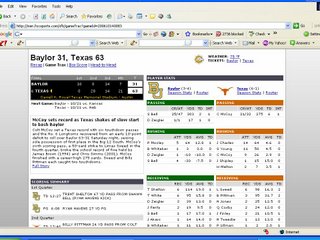
A Random quote:
Emergencies have always been necessary to progress. It was darkness which produced the lamp. It was fog that produced the compass. It was hunger that drove us to exploration. And it took a depression to teach us the real value of a job. - Victor Hugo (1802 - 1885)
* Though "Baylor Bails Out" (as was posted as headline earlier, and quickly removed) sounds good, it would be incorrect, as their loss was involuntary.
Saturday, October 14, 2006
WTFobia?!
 Looks like you name it, they find a word for it's phobia! I guess these phobics offer job security for wonderful people at Oxford and Webster's:-) Here are the five most common phobias:
Looks like you name it, they find a word for it's phobia! I guess these phobics offer job security for wonderful people at Oxford and Webster's:-) Here are the five most common phobias:1. Fear of snakes (ophidiophobia)* I wonder how the doctor breaks this news?! "Mr. Adams, you have Hippo..." and he faints! I am sure the same mean-spirited guy/gal who invented this word also invented the word "Lisp". Seriously, imagine how hard it would be for a person with Lisp to say Lisp!
2. Fear of giving a speech (glossophobia)
3. Fear of heights (acrophobia)
4. Fear of rodents (musophobia)
5. Fear of flying (aviophobia)
Here is a list of few phobias - some well known, some not so well known.
Papaphobia - fear of the pope.
Scorodophobia - fear of garlic.
Pteronophobia - fear of being tickled with feathers.
Ranidaphobia - fear of frogs.
Philematophobia - fear of kissing.
Aulophobia - fear of flutes.
Ostraconophobia - fear of shellfish.
Graphophobia - fear of handwriting.
Hippopotomonstrosesquippedaliophobia - fear of long words (seriously)*
Blennophobia - fear of slime.
Gerontophobia - fear of old people.
Peladophobia - fear of bald people.(I am Peladophobiacphobic!)
Geropeladophobia - fear of old, bald people.
Phobophobia - fear of developing a fear.
Source for phobias and the graphic: msn.com
Friday, October 13, 2006
Nothin' ain't movin' no where!*
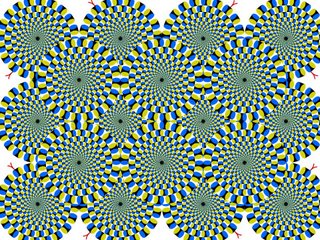
If you look at these circles from a close distance, they appear to be in motion. But nothing is moving here! Pretty neat illusion. Reminds me of a quote some what related to this, in the movie The Matrix. While Neo was waiting to see the Oracle, he notices a little boy bending a spoon just by looking at it. Neo picks up the spoon, and tries to understand what was going on, and the following conversation ensues.
Spoon boy: Do not try and bend the spoon. That's impossible. Instead only try to realize the truth.* Like this kind of talk with excessive negatives by Moe Szyslak in Simpsons.
Neo: What truth?
Spoon boy: There is no spoon.
Neo: There is no spoon?
Spoon boy: Then you'll see that it is not the spoon that bends, it is only yourself.
Thursday, October 12, 2006
Counting Crows:-)
On an unrelated topic about crows (for Telugu speaking folks), when I was a kid my అమ్మ told me this (a mild) tongue twister: కాకీక కాకికి కాక కేకికా! ( కేకి = నెమలి in Telugu)The story of the following experiment was told in a university classroom by a professor of psychology. I cannot vouch for the validity of the specific numerical conclusions drawn from it, since I could not check it first-hand. But I shall cite it here, because it is the most illuminating way to illustrate a certain fundamental aspect of consciousness--of any consciousness, animal or human.
The experiment was conducted to ascertain the extent of the ability of birds to deal with numbers. A hidden observer watched the behavior of a flock of crows gathered in a clearing in the woods. When a man came into the clearing and went on into the woods, the crows hid in the tree tops and would not come out until he returned and left the way he had come. When three men went into the woods and only two returned, the crows would not come out: they waited until the third one had left. But when five men went into the woods and only four returned, the crows came out of hiding. Apparently, their power of discrimination did not extend beyond three units--and their perceptual-mathematical ability consisted of a sequence such as: one-two-three-many (Rand 1967, 57).
A Random funny quote:
Time flies like an arrow. Fruit flies like a banana.- Groucho Marx
Wednesday, October 11, 2006
Panacea!
Tuesday, October 10, 2006
No Monkey Business!
In September, following complaints of diners, the health department in Springfield, Mo., notified restaurants that Debby Rose's "assistance monkey" could not be permitted to dine with her (in a high chair), even though Rose said she suffers from a disabling social phobia that she can accommodate only if "Richard" (a bonnet macaque monkey) is with her. Monkeys are generally permitted under the Americans with Disabilities Act if they perform certain tasks, as capuchin monkeys have been trained to fetch groceries from shelves for wheelchair-using patrons. However, animals that provide only emotional support fall into a gray area, according to a U.S. Justice Department spokesperson quoted by the Springfield News-Leader. [ABC News-AP, 9-16-06]A Random Quote:
The trouble ain't that there is too many fools, but that the lightning ain't distributed right.- Mark Twain
Monday, October 9, 2006
Bose the Boss of Bass!
In 1956, while a graduate student at MIT, Dr. Bose purchased a high-end stereo system and was disappointed when it failed to meet his expectations. He later began extensive audio research aimed at fixing what he saw as key weaknesses plaguing such high-end systems. The principal weakness, as he saw it, was how the overall design of the loudspeakers and electronics failed to take into account psychoacoustics (the human perception of sound). Eight years later, he founded the company, charging it with a mission to achieve Better Sound Through Research (which is also the company's slogan).It just occurred to me that there are a few well reputed Bose's. S.N. Bose, the founder of Boson, S.C. Bose, the freedom fighter, and J.C. Bose, Bengali Sci-Fi writer(!), plant Physicist, and physicist. Here is something that I did not know about J.C. Bose until now (some excerpts from Wikipedia).
In November of 1894, the Indian physicist, Jagdish Chandra Bose, demonstrated publicly the use of radio waves in Calcutta, but he was not interested in patenting his work. Bose ignited gunpowder and rang a bell at a distance using electromagnetic waves, proving that communication signals can be sent without using wires.I am curious if staple diet of fish and rice improves creativity. Because, this is a common denominator for Japanese and Bangla babus. As we know, the nutrients and climate influence the nature of plant species; hence the difference between Basmati rice and Jasmine rice, etc. Why can't it be true for humans and animals too?Nutrients I believe can override the genetic programming (no basis, just a hunch)
In 1896, the Daily Chronicle of England reported on his UHF experiments: "The inventor (J.C. Bose) has transmitted signals to a distance of nearly a mile and herein lies the first and obvious and exceedingly valuable application of this new theoretical marvel."
The 1895 public demonstration by Bose in Calcutta was before Marconi's wireless signalling experiment on Salisbury Plain in England in May 1897. But Tesla demonstrated radio communication earlier, in 1892 and 1893.
Bose was not interested in the commercial applications of the experiment's transmitter. He did not try to file patent protection for sending signals. In 1899, Bose announced the development of a "iron-mercury-iron coherer with telephone detector" in a paper presented at the Royal Society, London.
Later he received U.S. Patent 755840, "Detector for electrical distrubances" (1904), for a specific electromagntic receiver. He is not known for greatly contributing to the development of commercial radio communication and did not file any patents for transmission, but he deserves recognition for contributing to the development of radio.
A Random Quote:
Telling the truth to people who misunderstand you is generally promoting a falsehood, isn't it? - Anonymous
Sunday, October 8, 2006
A Dumbbell for Left Brain!
There are three brothers. The product of their ages is 36. The sum of their ages is equal to the age of their only sister. The three brothers never admit their ages, but their sister always admits her own. Even so, you need to know that the oldest brother usually wears his baseball cap backward. How old is each brother?Somewhat related quote:
The great pleasure and feeling in my right brain is more than my left brain can find the words to tell you.-Nobel Laureate Roger Sperry.Answers:
(1) Jason! His name is spelled with the first letter of the seventh through the 11th months: July (J) through November (N).
(2) 50 lbs (if 1 lb = 2%, 100% will be 50 lbs)
Saturday, October 7, 2006
The Real McCoy!

Enjoyed watching Texas winning over OU 28-10. Colt McCoy (Quarter Back) and his team will be bringing the 10-gallon Gold Cowboy Hat to Austin again!
Solution:
The only combinations of three ages whose product is 36 are: 1x1x36, 1x2x18, 1x3x12, 1x4x9, 1x6x6, 2x2x9, 2x3x6, and 3x3x4. Except for two of the combinations, all their sums are different. Say that you ask the sister her age. If her age were the same as any of those sums, you would know the ages of the brothers. But because you need to know that the oldest brother usually wears his baseball cap backward, her age must be the sum of that’s shared by two combinations: 13 (1, 6, 6 or 2, 2, 9). Only one of these two combinations has an “oldest” brother, which means 2, 2, and 9 years in the answer.
Red River Shootout
Winning is not a sometime thing; it's an all the time thing. You don't win once in a while; you don't do things right once in a while; you do them right all the time. Winning is a habit. Unfortunately, so is losing.Related Quote:
"There is no room for second place. There is only one place in my game, and that's first place. I have finished second twice in my time at Green Bay, and I don't ever want to finish second again. There is a second place bowl game, but it is a game for losers played by losers. It is and always has been an American zeal to be first in anything we do, and to win, and to win, and to win.
"Every time a football player goes to ply his trade he's got to play from the ground up - from the soles of his feet right up to his head. Every inch of him has to play. Some guys play with their heads. That's O.K. You've got to be smart to be number one in any business. But more importantly, you've got to play with your heart, with every fiber of your body. If you're lucky enough to find a guy with a lot of head and a lot of heart, he's never going to come off the field second.
"Running a football team is no different than running any other kind of organization - an army, a political party or a business. The principles are the same. The object is to win - to beat the other guy. Maybe that sounds hard or cruel. I don't think it is.
"It is a reality of life that men are competitive and the most competitive games draw the most competitive men. That's why they are there - to compete. To know the rules and objectives when they get in the game. The object is to win fairly, squarely, by the rules - but to win.
"And in truth, I've never known a man worth his salt who in the long run, deep down in his heart, didn't appreciate the grind, the discipline. There is something in good men that really yearns for discipline and the harsh reality of head to head combat.
"I don't say these things because I believe in the "brute" nature of man or that men must be brutalized to be combative. I believe in God, and I believe in human decency. But I firmly believe that any man's finest hour, the greatest fulfillment of all that he holds dear, is that moment when he has worked his heart out in a good cause and lies exhausted on the field of battle - victorious.
The person who said "it doesn't matters whether you win or lose; what counts is how you played" probably was a loser - Source Unknown
Friday, October 6, 2006
Was Lord Rama a Frequent Flyer?
Anyway, he once mentioned about descriptions of Vimanas in the book Bermuda Triangle by Charles Berlitz. This book is in my "to read" list and is yet to make it to the top. Here is an interesting excerpt from this book that I found on the web.
In another ancient Indian classic, the Ramayana, there are curious descriptions of travels by airplane, thousands of years ago. The details of the landscapes over Ceylon and over parts of the Indian shores are described with a so great naturalness and are so similar to those we can see today, the beach reeves, the curve of the Earth, the slopes of the hills, the appearance of the cities and of the forests, to almost convince the reader of the fact that some aerial travelers of the ancient past have really seen the Earth from the sky, instead of imagining it. In a contemporary epitome of the Ramayana, the Mahavira Charita, the good hero Rama, returned from Lanka, where he just saved his wife Sita, receives as a gift a special vimana, described in this way: "Without obstacles at the motion, capable to maintain the desired speed, perfect in controls, always obedient the will (of who drives it) supplied with little sitting-rooms with windows and excellent seats...", a case in which an ancient classic seems a modern advertisement for the Air India. In the same text we find a very amazing dialogue, if we consider that it precedes of several thousands of years the reality of the space flights, and also the observation on how things look from space.Random Quote:
Rama: "It seems that the motion of this excellent vehicle has changed ".
Vishishara: " Now this vehicle is going away from the closeness of the center of the world ".
Sita: " Why this circle of stars is visible... even at daylight? "
Rama: " Queen! It's really a circle of stars, but because of the huge distance we can't see it at daylight, because our eyes are darkened by the sunlight. But now, with the ascent of the vehicle, it happens no more... ( and so we can see the stars)".
The greatest events - are not our noisiest, but our stillest hours - Fredrich Nietzsche
Thursday, October 5, 2006
How to Spot a Desi Returned from the US?!
10. Says "Oh" instead of "Zero", (for 704, says Seven Oh Four Instead of Seven Zero Four)Loved # 6!
9. Makes fun of Indian Standard Time and Indian Road Conditions.
8. Doesn't forget to crib about air pollution. Keeps cribbing every time he steps out.
7. Says all the distances in Miles (Not in KiloMeters), and counts in Millions.(Not in Lakhs)
6. Tries to figure all the prices in Dollars as far as possible (but deep down the heart multiplies by 43 times).
5. When need to say Z (zed), never says Z (Zed), repeats "Zee" several times, if the other person unable to get, then says X, Y, Zee (but never says Zed).
4. Even after 2 months, complaints about "Jet Lag".
3. Tries to complain about any thing in India as if he is experiencing it for the first time.
2. Tries to begin conversation with "In US ...." or "When I was in US..."
1. From the luggage bag, does not remove the stickers of Airways by which he traveled back to India, even after 4 months of arrival.
Wednesday, October 4, 2006
Rat's Brain Atlas, At Last!
Allen Institute for Brain Science Completes Brain AtlasThough Human brain can be a lot more complex, I guess this data might throw some insight on how W's brain functions, and the rationale (if any) behind his decisions!
SEATTLE - Sept. 26, 2006 - The completion of the Allen Institute for Brain Science's inaugural project signals a remarkable leap forward in one of the last frontiers of medical science - the brain.
The Institute today announced the completion of the groundbreaking Allen Brain Atlas, a Webbased, three-dimensional map of gene expression in the mouse brain. Detailing more than 21,000 genes at the cellular level, the Atlas provides scientists with a level of data previously not available.
Bush Quote:
We've tripled the amount of money - I believe it's from $50 million up to $195 million available.- Lima, Peru, March 23, 2002

Tuesday, October 3, 2006
Do you Consider Yourself a "Professional"?
1. How do you put a giraffe into a refrigerator?
2. How do you put an elephant into a refrigerator?
3. The Lion King is hosting an animal conference. All the animals attend except one. Which animal does not attend?
4. There is a river you must cross. But it is inhabited by crocodiles. How do you manage it?
ANSWERS
1 The correct answer is: Open the refrigerator put in the giraffe and close the door. This question tests whether you tend to do simple things in an overly complicated way.
2. Open the refrigerator put in the elephant and close the refrigerator. Wrong Answer!
Correct Answer: Open the refrigerator, take out the giraffe, put in the elephant and close the door. This tests your ability to think through previous actions.
3. Correct Answer: The Elephant. The elephant is in the refrigerator. This tests your memory. OK, even if you did not answer the first three questions correctly, you still have one more chance to show your true ability.
4. Correct Answer: You swim across. All the crocodiles are attending the Animal Conference. This tests whether you learn quickly from your mistakes.
Source: E-mail from my Ex-Colleague Mike Trojan
A Random Quote:
Ageing isn't that bad if you consider the alternatives . - Maurice Chevalier
Monday, October 2, 2006
Wise Cracks!
OK, folks, hold the applause and drop your drawers! I'm George Nelson, and I'm here to sack the city Itta Bena!He robs the money from the cashier and says:
Thank you, folks. And remember, Jesus saves, but George Nelson withdraws!Reminded me of one of the Simpsons episodes where Mr. Burns, while snatching some expensive paintings from Grandpa Simpson in a hurry goes:
As they say, "time is Monet"A random quote:
My psychiatrist told me I'm going crazy.
I told him, 'If you don't mind I'd like a second opinion.'
He said, 'Alright.... you're ugly too!' - Late Rodney Dangerfield
